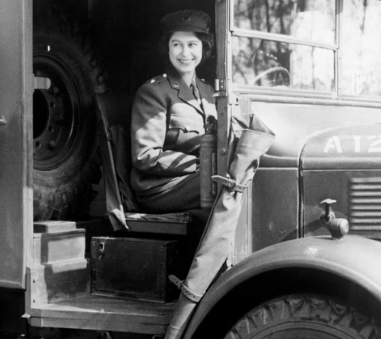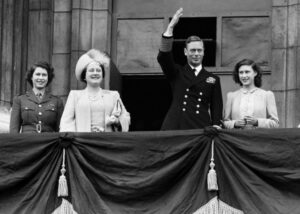The Night the War Ended in Europe
May 8, 1945, known as Victory in Europe (VE) Day, marked the end of the Second World War in Europe. For many across the Allied nations, the day was one of unrestrained joy, of collective exhalation after nearly six years of brutal conflict. Among those swept up in the euphoria was a young Princess Elizabeth—future Queen Elizabeth II—who, alongside her sister Princess Margaret, took to the streets of London in a moment of profound anonymity, youthful adventure, and shared celebration. As the world commemorates the 80th anniversary of VE Day in 2025, the late Queen’s reflections on that singular night have resurfaced, offering not just a window into royal life during wartime, but a vivid evocation of human spirit in times of victory.
Chapter One: A Royal Childhood in Wartime
Born in 1926, Princess Elizabeth Alexandra Mary Windsor was just 13 when Britain declared war on Nazi Germany in 1939. As the eldest daughter of King George VI and Queen Elizabeth (later known as the Queen Mother), she came of age in a nation besieged by air raids, rationing, and national service. Yet her experiences, while shaped by privilege, were nonetheless marked by duty, resilience, and a powerful sense of unity.
The royal family chose to remain in London during the Blitz, with Buckingham Palace itself bombed on multiple occasions. The King and Queen famously refused to flee to Canada, opting instead to share the hardship of their people. Elizabeth and Margaret were initially relocated to Windsor Castle for safety, but the weight of national expectation soon returned them to the capital. By 1945, Princess Elizabeth, now 19, was already a symbol of continuity and hope—her wartime broadcasts to children and her newly minted role as a Second Subaltern in the Auxiliary Territorial Service (ATS) embodying the monarchy’s public duty.
Chapter Two: A Nation Awash in Celebration
When news broke on May 7, 1945, that Germany had surrendered unconditionally to Allied forces, the response was instantaneous. Crowds surged into Trafalgar Square, Piccadilly Circus, and The Mall. Bonfires lit the night, flags waved from every window, and church bells rang across the United Kingdom for the first time since the war had begun. Prime Minister Winston Churchill addressed the nation, while the King prepared to speak that evening.
But it was the streets—alive with the singing of “Land of Hope and Glory” and impromptu dancing—that truly captured the spirit of the moment. People wept openly, kissed strangers, and climbed lampposts. For the British public, May 8 was a day when their endurance had finally borne fruit, when the losses of Dunkirk, the Blitz, and the long rationed years were answered by relief and renewed faith.
Into this sea of celebration slipped two of the most famous young women in the world—unrecognized, unguarded, and unburdened, if only for a night.
Chapter Three: “We Were Terrified of Being Recognized”
In later interviews and recollections, including a 1985 BBC documentary and a private letter revealed in royal archives, Queen Elizabeth remembered VE Day as “one of the most memorable nights of my life.” What made it so enduring? It wasn’t her father’s historic speech from Buckingham Palace’s balcony or the family’s official appearances. It was the fact that, just once, she experienced what it was like to be a regular teenager.
Alongside her 14-year-old sister Margaret and accompanied by a small group of royal aides and trusted friends, Elizabeth left Buckingham Palace incognito, blending into the crowd. “We asked my parents if we could go out and see for ourselves,” the Queen recalled. “I remember we were terrified of being recognized.” Wearing her ATS uniform, she joined the throng outside the palace gates and wandered as far as the Ritz, dancing arm in arm with strangers, caught up in the spontaneous rhythm of peace.
Reports from the time, corroborated later by royal insiders, describe the group slipping through the palace gates at about 9 p.m. and not returning until after midnight. “I remember lines of unknown people linking arms and walking down Whitehall, all of us just swept along on a tide of happiness and relief,” Elizabeth said in the same interview.
Chapter Four: The Young Monarch in Waiting
This moment of rebellion—brief and carefully measured—stood in contrast to Elizabeth’s otherwise orderly, highly disciplined life. Even at 19, she was conscious of her eventual role as monarch. Yet the decision to experience VE Day as one of the people reveals a deeply empathetic streak, one that would define her 70-year reign.
Queen Elizabeth II’s accession to the throne in 1952 marked the beginning of a new post-war chapter for Britain. Still, she often referred back to the lessons of the war. She described VE Day not simply as the end of conflict, but as the beginning of civic renewal, a period when the country banded together to rebuild shattered cities, families, and futures.
In a 1995 speech commemorating the 50th anniversary of the war’s end, she said: “We lost so many, and so much, but we gained strength, unity, and the knowledge that freedom once earned must never be surrendered.”
Chapter Five: Personal Remembrance, Public Memory
The resurfacing of Queen Elizabeth’s VE Day reflections for the 80th anniversary in 2025 speaks to the enduring fascination with how public figures experience private emotions during national turning points. Excerpts from her personal diary and recently declassified letters show a young woman deeply attuned to the gravity of the moment. In one note, she writes: “The lights are on again in London, and I felt as though the whole city was exhaling.”
This idea of shared breath—a national release—carries through the archival footage now being aired as part of the BBC’s anniversary programming. Viewers see young women dancing in uniform, servicemen kissing the pavement, and among them, somewhere, the future Queen, unseen and joyous.
Historians and royal biographers have long pointed to VE Day as a moment of personal formation for Elizabeth. “It was the first and last time she was able to move through the world as an ordinary citizen,” says Dr. Louise Bartlett, a royal historian at King’s College London. “That night taught her something about the people she would serve—not from a distance, but from the crowd.”
Chapter Six: The Palace, the People, and the Future
The 80th anniversary of VE Day has inspired a wave of tributes across the UK and Commonwealth. At Buckingham Palace, a projection of archival photos—including a silhouette of Princess Elizabeth in uniform—lights the building’s façade each evening leading up to May 8. King Charles III and Queen Camilla are set to lead the commemorations, laying wreaths at the Cenotaph and hosting veterans at a garden reception.
Younger royals, including Prince William and Princess Catherine, have recorded messages reading excerpts from wartime letters. In these ceremonies, the late Queen’s memory serves not only as a link to the past but as a bridge across generations—a reminder of the unity forged in crisis.
In a statement from the Palace, King Charles recalled his mother’s story of the night, saying: “My mother always held that evening close to her heart—not only for the joy it brought, but for what it taught her about the spirit of this country.”
Impression
Eighty years on, Queen Elizabeth II’s account of VE Day still resonates—not as a tale of royal escapade, but as a reflection of the uniquely British blend of solemnity and celebration. Her memories, once shared in a whisper, are now spoken aloud across airwaves and ceremonies, serving as a national inheritance.
In a world now facing new uncertainties, her night among the people reminds us of what peace feels like when it’s finally grasped. And what leadership looks like when it’s shaped by empathy, humility, and a willingness—even just once—to take off the crown and join the crowd.
No comments yet.








